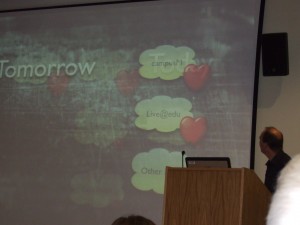It’s all gone horribly wrong – disaster communication in a crisis: Jeremy Speller
9:07 am in plenaries by kirsty-pitkin
Speller’s talk took us through the range of web-based communication options available to ensure messages get out in a range of crisis situations and argued that web teams need to be actively involved in advising their institutions’ crisis plans. Very often these plans omit the web team. Speller emphasised that web teams are communications experts and should be advising the other parties, as well as considering how best to protect their own systems, upon which the operation of the institution and its staff and students rely.
Speller asked us to consider the tools that could be our “megaphones of communication” and used a love heart illustration, which varied in size to indicate his own preference for certain options. Whilst he acknowledged the use of tools such as Twitter and Facebook for communication in a disaster situation, he emphasised the need to link these in to updates from a central source. He recommended the use of JANET, which provides a bunkered, off-site system. The advantage of this is that it offers a virtual server, on which you can install WordPress. WordPress can be linked easily with a variety of other tools (including Twitter) using plugins. Because this is your own installation of WordPress, you have control over the plugins (which you do not with a WordPress.com site), so you have greater flexibility and fewer unknowns!
He outlined some of the information dissemination routes which have an inherent level of unreliability, usually because the data involved is prone to being incomplete or inaccurate. This included using student and staff personal (non-university) email addresses and mobile telephone numbers. However, he noted the potential to keep university email services going in the event of a disaster affecting the university servers for those using Live@edu.
Speller also outlined a suggested system of offering university web service back up as a shared service. He noted that this may not work well between just two institutions, illustrating with UCL and St Andrews (UCL may be confident with St Andrews maintaining an emergency version of their site, but St Andrews may find a London-based back up of theirs may not help in the event of certain types of disaster). However, if a network was established, this could be an effective route to keep the basics going in a cost effective way.
To conclude, he reminded us that in the worse-case scenario, there was always the option of a megaphone! We can be prepared, but there will always be situations where nothing is available. In the questions, Chris Gutteridge of University of Southampton described the situation they found themselves in when their back up essential “black box” survived as designed, but fire crews would not allow access to it for 7 weeks. He explained what they had learnt from the process of coping without it and how their emergency plans had been strengthened by this. Brian Kelly also noted how information in an emergency would not always be provided by the university, but perhaps by other agencies, like the local travel company. Working together with these information providers would also make the university crisis plan more resilient.
Jeremy’s slides are available at Slideshare here.
